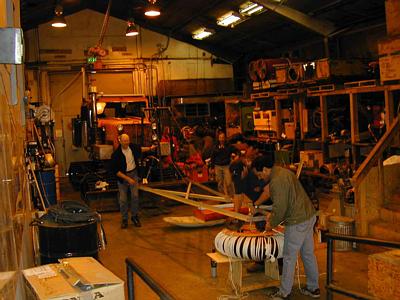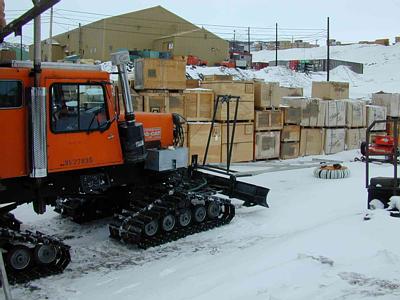20 November, 1999
International Tran-Antarctic Science Expedition!
Today I want to tell you about the International Trans-Antarctic Science
Expedition (ITASE); a project that has many components with lots of
questions being asked and with collaboration with scientists from several
countries. Dr. Steve Arcone is a scientist from the Cold Region Research
and Engineering Labs (CRREL) and is an expert in radar detection of layering
in the ice and snow.
In an attempt to understand major climate changes and predict future drastic
changes, scientists are trying to understand when the glacier ice cover
developed in Antarctica. As part of a way to answer the bigger question
there are many other smaller questions that will add information for
interpretation by the synthesizer people who look at all of the data from
many projects. Some smaller questions are as follows:
How fast is snow accumulating? Is the rate rising or falling?
How fast has snow accumulated since humans started serious coal burning?
How can we accurately date ice cores?
Can we find common global events that can be found in the ice?
Can we use these events as a marker for analyzing the ice cores?
Is the West Antarctic Ice Sheet stable or not? Will it melt and slide into
the Southern Ocean?
These are just a few of the questions the answers to which, with some data,
will contribute to our understanding of global climate change. I will first
give you some background on the West Antarctic Ice Sheet, then tell you
about the data collection by radar and of what use that data will be.
The West Antarctic ice sheet includes the area west of the Trans-Antarctic
Mountain Range. It is thought that this area is mostly an area of islands
and ocean rather than continuous land. This might be much like the San Juan
Islands in the Pacific Northwest. This means that much of the West
Antarctic Ice Sheet is lower than sea level and it is about 2000 meters
thick. It is also thought that this ice sheet is "riding" on a thin film of
liquid water. This liquid water could be the result of the pressure from
2000 meters of ice causing warming enough to melt and form a super-cooled
fresh water liquid that is colder than the freezing point normally true for
water. Another factor that may be contributing to the liquid layer under
the ice is the fact that Ross Sea water could be seeping in under the ice
since the area is really an archipelago of islands rather than a land mass.
Maybe the ice sheet is "floating" on seawater much like ice that floats.
There is evidence of very small changes (in mm) that might be caused by this
floating. (At least some think that is one way to interpret the data) We
know that there is liquid under this ice sheet because of the ice streams
that have been measured as the ice flows over the islands. There are five
identified ice streams identified and labeled A -E. The ice streams have
regularly flowed about 300 - 400 meters per year. They move toward and into
the Ross Ice Sheet and the Ross Sea. The ice in East Antarctica is on land
and is moving very slowly compared to the West Antarctic Ice Sheet. The ice
in East Antarctica moves only 10 meters per year. It moves very slowly
because there is no liquid underlying the ice. To move, it creeps one ice
crystal at a time over the crystal in front of it.
How can we answer the question of how fast is snow accumulating? Has there
been a change since we started burning coal? Using radar as a detection
device, one can measure the layers of ice. But, you need to know how old
the ice layers are so that you can make meaning from the data on the layers
found within the ice cores. One way to determine age of layers within the
ice core is to look for markers of known events from the past. This group
of scientist is using volcanic eruptions from the past and correlating known
events with depth within the ice core where the event occurred. The
following "volcanic fingerprints" were found for the 1793 Laki eruption in
Iceland; the 1815 Tambora eruption in Indonesia; the 1883 Krakatau eruption
near Indonesia; the 1912 Katmai eruption in Alaska and the 1991 Pinatubo
eruption. When these eruptions occurred, they not only spewed out rock and
dust parcticles, but lots of sulfuric acid. This acid was distributed in the
atmosphere around the world and rained /snowed on all the land. Each
eruption resulted in a signature profile of the eruption which when snowed
upon in Antarctica, became trapped within the ice. So now when a layer of
ice is analyzed and compared with a known volcanic event in the past, we
know how deep the known layer is so we know how much snow and ice has
accumulated since that event. With several markers in place, analyzing an
ice core becomes much easier. The Tambbora 1815 eruption evidence is found
at 33 meters deep in the ice.
Can you now find a way to tell if snow is accumulating rapidly, or not
accumulating at all? What other information might be of value? You might
want to know that during present time it snows about 11 cm per year. That
translates into about 3/4th of an inch of water per year. This is what is
found in the layers of ice. There is another factor to consider; that of
compression under pressure. Those 11 centimeters of snow that fell a few
years ago will compact into about 2 centimeters further down into the ice.
Now you know why we need Dr. Steve Arcone and his radar. Using his radar,
he can detect the layers and distinguish one from another down to about 50
meters. He can also detect whether or not the layers are straight. Why
might this make a difference? What might cause layers to not be flat?
If you guessed that the ice bumps up against buried islands and folds around
them you are thinking like a scientist. The radar is useful to find good
places to take a core of ice. The plan is to take a core of ice every 10n
kilometers as they travel along in a large Tucker (a huge tractor like
vehicle that moves like a treadmill). In order to make good use of a core,
the team must make sure that the core that is taken has flat layers of ice
with no folding patterns. Why is folding in an ice core used answer the
question about patterns of snowfall in years past a problem?
What other things might influence his data? Think about riding along in
this Tucker with the radar device suspended from the front of the vehicle
hovering about 30 centimeters above the ice, protected by an airplane tire
innertube
What other use might there be for looking at the layers under the ice, or
other surfaces, for that matter?
One interesting use for this radar detection is that when the radar hits a
crevasse in the ice; one that may be covered by a snow bridge of drifting
snow; it will show up as a big break in the layers of ice. Aha! This is
where the radar has an n immediate and life saving value to the research
team as they traverse the West Antarctic Ice Sheet.
We can now return to the original question How fast is snow accumulating in
the West Antarctic Ice Sheet. We have a way to find layers. We can
identify specific layers correlated to known events. We can measure how much
ice accumulated each year and look for a pattern. Is there no change? Is
there an increase in precipitation? Is there a loss of ice?
Here are a few photos of Dr. Arcone talking with the people in my project.
Here is also a photo of getting the equipment rigged up and working.
Tomorrow I will tell you how this relates to predicting global climate
changes. In the mean time, see if you can figure out how to make use of the
information that will be gathered by this research group.
Then check out the web site http://www.secretsoftheice.org


Contact the TEA in the field at
.
If you cannot connect through your browser, copy the
TEA's e-mail address in the "To:" line of
your favorite e-mail package.
|
